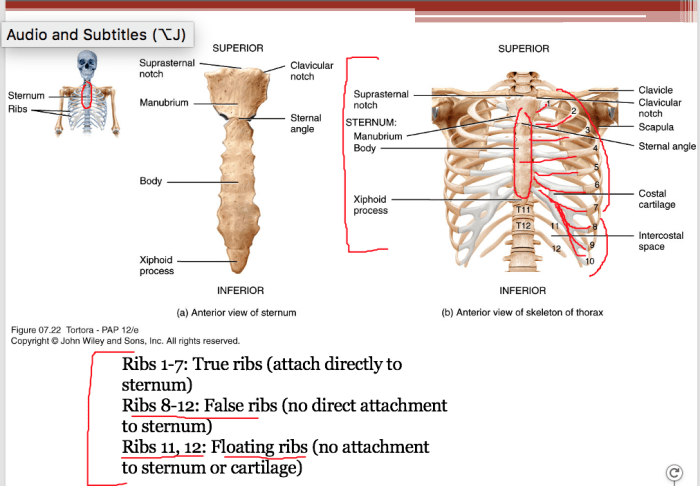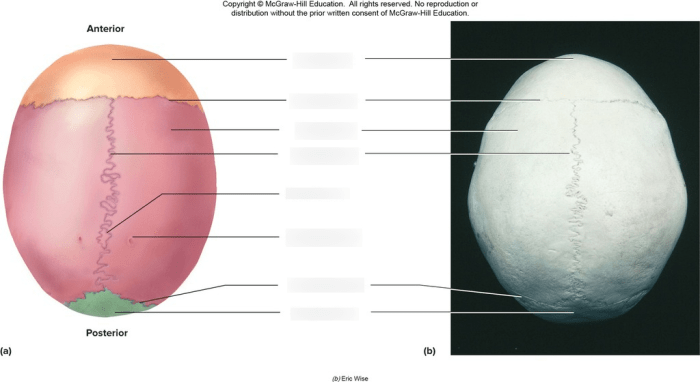Exercise 8 the axial skeleton – Embark on an enlightening journey into exercise 8: the axial skeleton. This exploration delves into the intricate structure and remarkable functions of the axial skeleton, unveiling its pivotal role in supporting, protecting, and enabling our movements.
From its evolutionary origins to its clinical significance, we will unravel the mysteries of this essential skeletal framework, uncovering its fascinating adaptations and the impact it has on our overall well-being.
Anatomy of the Axial Skeleton

The axial skeleton is the central structural framework of the body, forming the axis around which the limbs and other structures are attached. It provides support, protection, and mobility, and consists of the bones of the skull, vertebral column, and rib cage.
The axial skeleton can be divided into three main regions:
- The skull, which protects the brain and sensory organs, and provides attachment points for muscles involved in facial expressions and chewing.
- The vertebral column, which supports the body and provides flexibility, and protects the spinal cord.
- The rib cage, which protects the heart and lungs, and provides attachment points for muscles involved in breathing.
The bones of the axial skeleton are interconnected by joints, which allow for movement and flexibility. The joints between the vertebrae, for example, allow for bending and twisting of the spine, while the joints between the ribs and the sternum allow for expansion and contraction of the chest during breathing.
The axial skeleton is adapted to the specific needs of different species. In humans, for example, the vertebral column is S-shaped, which helps to absorb shock and protect the spinal cord from damage. In birds, the bones of the axial skeleton are hollow, which helps to reduce weight and make them more efficient at flying.
| Bone | Location | Function |
|---|---|---|
| Skull | Head | Protects the brain and sensory organs, provides attachment points for muscles |
| Vertebral column | Back | Supports the body, provides flexibility, protects the spinal cord |
| Rib cage | Chest | Protects the heart and lungs, provides attachment points for muscles involved in breathing |
Functions of the Axial Skeleton

The axial skeleton, composed of the skull, vertebral column, and rib cage, plays a crucial role in providing structural support, protection, and mobility for the body.
Support
The axial skeleton forms the central framework of the body, providing support for the entire structure. The vertebral column, in particular, bears the weight of the head and upper body, while the rib cage protects the vital organs in the chest cavity.
Protection, Exercise 8 the axial skeleton
The axial skeleton serves as a protective shield for delicate organs and tissues. The skull encloses the brain, providing protection from external forces. The vertebral column protects the spinal cord, while the rib cage safeguards the heart, lungs, and other thoracic organs.
Exercise 8: The Axial Skeleton delves into the bones that form the central axis of the body. To enhance your understanding, you may refer to the Alice K12 Post Test Answers for additional insights. These answers provide a comprehensive overview of the axial skeleton, its components, and their functions.
Returning to Exercise 8, the axial skeleton comprises the skull, vertebral column, and rib cage, forming the core structure of the body.
Movement
The axial skeleton also contributes to movement. The vertebral column allows for flexibility and range of motion, enabling bending, twisting, and other bodily movements. The rib cage facilitates breathing by expanding and contracting, aiding in the exchange of gases.
Comparison with Appendicular Skeleton
In contrast to the axial skeleton, the appendicular skeleton comprises the limbs and their associated bones. The appendicular skeleton is primarily responsible for locomotion and manipulation, while the axial skeleton focuses on support, protection, and movement of the central body.
Clinical Significance of the Axial Skeleton

The axial skeleton is the central and supporting structure of the human body, providing protection and support to vital organs, facilitating movement, and maintaining balance. However, it is also susceptible to various injuries and disorders that can significantly impact an individual’s overall health and well-being.
Common Injuries and Disorders
The axial skeleton is prone to fractures, especially in the vertebrae and ribs. Fractures can result from trauma, such as falls or accidents, and can cause pain, mobility limitations, and nerve damage. Osteoporosis, a condition characterized by reduced bone density, can weaken the axial skeleton, making it more susceptible to fractures.
Scoliosis, a lateral curvature of the spine, is another common disorder that affects the axial skeleton, causing back pain, muscle imbalances, and respiratory problems.
Role in Posture and Balance
The axial skeleton plays a crucial role in maintaining posture and balance. The spine, with its natural curves, supports the weight of the head and upper body while providing flexibility and shock absorption. The rib cage protects the heart and lungs and assists in breathing.
Proper posture and balance are essential for daily activities, reducing the risk of falls and injuries.
Diagnostic and Therapeutic Techniques
Diagnosing axial skeletal disorders involves a combination of physical examinations, imaging techniques such as X-rays, CT scans, and MRIs, and blood tests to assess bone density. Treatment options vary depending on the specific disorder and may include pain management, physical therapy, bracing, surgery, and medication to strengthen bones or correct spinal deformities.
Early diagnosis and appropriate treatment are crucial for managing axial skeletal disorders effectively and preventing long-term complications.
Evolutionary Considerations of the Axial Skeleton
The axial skeleton, consisting of the skull, vertebral column, and rib cage, has undergone significant evolutionary adaptations from early vertebrates to modern humans. These adaptations reflect the changing environmental pressures and functional demands placed on the axial skeleton over time.
From Aquatic to Terrestrial Life
Early vertebrates, such as fish, had a cartilaginous axial skeleton that provided buoyancy and support in water. As vertebrates transitioned to land, the axial skeleton evolved to support the weight of the body against gravity and facilitate terrestrial locomotion. This transition involved the development of a stronger, bony axial skeleton and the formation of specialized joints for movement.
Bipedalism and the Human Skeleton
The most significant evolutionary adaptation of the axial skeleton occurred in the transition from quadrupedal to bipedal locomotion in early hominins. Bipedalism required major changes in the shape and structure of the axial skeleton to maintain balance, support the upright posture, and facilitate efficient movement.
- Curvature of the Vertebral Column:The vertebral column developed curves (cervical, thoracic, lumbar, and sacral) to distribute weight, absorb shock, and provide flexibility for movement.
- Enlarged Pelvis:The pelvis widened and shortened to support the weight of the upper body and provide stability during bipedal gait.
- Rib Cage:The rib cage expanded to accommodate the larger lungs required for increased oxygen demand during bipedalism.
Implications for Human Movement and Function
The evolutionary adaptations of the axial skeleton have had profound implications for human movement and function. The strong, bony axial skeleton provides support and protection for vital organs and allows for a wide range of movements. The curves of the vertebral column enhance flexibility and shock absorption, while the enlarged pelvis facilitates bipedal gait and supports the weight of the upper body.
Frequently Asked Questions: Exercise 8 The Axial Skeleton
What is the axial skeleton?
The axial skeleton comprises the bones that form the central axis of the body, including the skull, vertebral column, and rib cage.
What are the primary functions of the axial skeleton?
The axial skeleton provides support, protection for vital organs, and facilitates movement by providing attachment points for muscles.
How does the axial skeleton differ from the appendicular skeleton?
The axial skeleton is fixed in place, while the appendicular skeleton consists of the bones of the limbs, which are movable and allow for a wide range of movements.